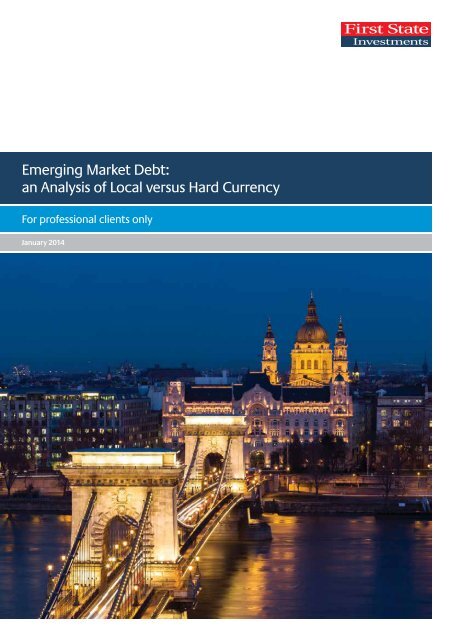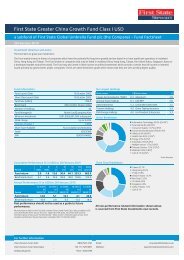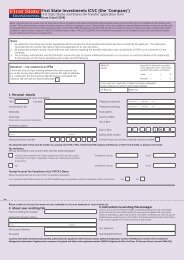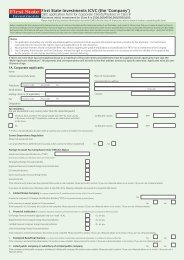Download PDF - First State Investments
Download PDF - First State Investments
Download PDF - First State Investments
Create successful ePaper yourself
Turn your PDF publications into a flip-book with our unique Google optimized e-Paper software.
Emerging Market Debt:<br />
an Analysis of Local versus Hard Currency<br />
For professional clients only<br />
January 2014
<strong>First</strong> <strong>State</strong> <strong>Investments</strong><br />
Emerging Market Debt<br />
Manuel Cañas,<br />
portfolio manager<br />
in the <strong>First</strong> <strong>State</strong><br />
Emerging Markets<br />
Debt team, discusses<br />
the relative merits<br />
of local and hard<br />
currency debt.<br />
Manuel Cañas – <strong>First</strong> <strong>State</strong> Emerging<br />
Markets Debt<br />
Manuel is a Senior Portfolio<br />
Manager in <strong>First</strong> <strong>State</strong> <strong>Investments</strong>’<br />
Emerging Markets Debt team,<br />
where he is responsible for<br />
researching the Latin American<br />
region. Before joining the company<br />
in November 2011, Manuel spent<br />
four years with ING Investment<br />
as Senior Investment Manager of<br />
Emerging Markets Debt funds and<br />
four years with the Central Bank of<br />
Argentina. He has a total of 15 years’<br />
experience in emerging markets.<br />
A CFA charterholder, Manuel holds<br />
a Licentiate in Economics from the<br />
University of San Andrés. A native<br />
Spanish speaker, Manuel is also<br />
fluent in Portuguese.<br />
External debt and local currency debt have a lot in common, with the<br />
return on both dependent on the EM (emerging market) risk premium.<br />
The historical yearly correlation of returns between the two is 0.79.<br />
If overall market conditions are conducive for risk-taking, the risk premia<br />
embedded in both external and local assets should compress.<br />
However, some key drivers for EM external and local debt performance<br />
differ, which implies that over the course of the global business cycle,<br />
their respective expected return/risk profiles fluctuate.<br />
As a result, investors may want to change the composition of their EM<br />
exposure depending on their market views. To make these decisions,<br />
and identify which sub-asset class offers a better risk/return trade-off,<br />
we look at a range of factors.<br />
<strong>First</strong>ly, we assess the fundamental global environment for the time<br />
framework under consideration for the investment decision. Typically,<br />
this means we will look well beyond our EM debt asset class to identify<br />
the key developments shaping economic trends in the global economy.<br />
Of particular interest are the global growth and inflation dynamics.<br />
At the same time, we look at valuations from both an absolute<br />
perspective, as well as relative to each other and relative to other<br />
comparable assets. Finally, we consider technical factors such as<br />
supply, flows, and risk appetite.<br />
Annual returns: external debt vs local debt<br />
25.7%<br />
16.9%<br />
11.7%<br />
23.0%<br />
10.7% 9.9%<br />
6.3%<br />
15.2%<br />
6.3%<br />
18.1%<br />
-5.2%<br />
28.2%<br />
-10.9%<br />
2003 2004 2005 2006 2007 2008 2009 2010 2011 2012 YTD2012<br />
22.0%<br />
15.7%<br />
12.0%<br />
8.5%<br />
-1.8%<br />
EMBIG<br />
GBI-EM Global Div*<br />
18.5%<br />
16.8%<br />
3.3%<br />
0.5%<br />
* Unhedged in USD. Source: JP Morgan as at 30 April 2013
Emerging Market Debt<br />
The impact of global growth<br />
The rate of global economic growth is typically one factor which affects<br />
both external and local assets. However, the difference between the<br />
pace at which developed and emerging economies grow also has direct<br />
implications for currencies which, after all, are priced in relative terms to<br />
one another.<br />
Monetary policy in developed countries is also important for multiple<br />
reasons: interest rate differentials are pivotal for currency performance,<br />
central bank management of expectations influences the term premium,<br />
and continued supply of liquidity tends to trickle down and compress<br />
risk premia.<br />
In terms of sovereign creditworthiness, external debt assets are far more<br />
sensitive to both levels and trends in credit ratings than local currency<br />
assets simply because default episodes are more common in the former<br />
than in the latter.<br />
Countries need to secure access to foreign exchange before they can service<br />
their external debt, while paying local debt is a matter of printing their own<br />
currency. Finally, in assessing country-specific developments, the focus of<br />
external debt is more on fiscal and external sector dynamics while for local<br />
currency debt inflation and monetary policy are at the fore.<br />
Valuations<br />
In terms of valuing external debt, we look at absolute and relative valuations.<br />
We believe that both the level of yields and spreads are relevant when<br />
assessing the attractiveness of sovereign credit. We compare the trend<br />
of spreads vis-à-vis the estimated risk of default, but also on a cross-asset<br />
perspective. In other words, how does the risk premium offered by<br />
EM sovereigns compare to similarly-rated assets: US investment grade<br />
corporates or US high yield, for example.<br />
The challenge of assessing valuations is compounded by the fact that<br />
over the past few years the Federal Reserve has intervened decisively in<br />
the US Treasury market, in an attempt to lower long rates to stimulate<br />
economic growth. This means that the entire valuation exercise hinges<br />
on a view of a heavily manipulated market (US Treasuries) with diminishing<br />
levels of float.<br />
As for local currency debt, the short-ends of the curves are anchored<br />
by expectations of monetary policy, but long-ends embed multiple<br />
premia: inflation (the flip side to the central bank’s credibility), term and<br />
risk. Term premium is in most cases mean-reverting, but risk premium is<br />
the one we care most about when assessing valuation. We look at this<br />
on a relative basis to the premia observed in other risky assets, including<br />
external debt. Correlation analysis gives us a good idea of how much of<br />
the total premium is actually risk, simply by comparing its performance<br />
over periods of time where volatility of risky assets is high.<br />
When looking at foreign exchange valuations, we consider the following<br />
approaches: real effective exchange rates, which track multilateral<br />
exchange rates (typically trade-weighted baskets) adjusted for the<br />
differential rates of inflation; current-account balance equilibrium<br />
approaches, which essentially reverse-engineers the nominal exchange<br />
rate that would achieve equilibrium in external accounts; and other<br />
broader, more complex, models that account for relative changes<br />
in total factor productivity.
<strong>First</strong> <strong>State</strong> <strong>Investments</strong><br />
Emerging Market Debt<br />
Selected EM currencies real effective exchange rates<br />
(source: BIS, as at 30 April 2013)<br />
150<br />
140<br />
130<br />
120<br />
110<br />
100<br />
90<br />
80<br />
70<br />
60<br />
50<br />
2007 2008 2009 2010 2011 2012 2013<br />
Note: All exchange rates are rebased to 100 at Jan 2007.<br />
Source: Bank of International Settlements as at 30 April 2013<br />
Mexico<br />
Brazil<br />
South Africa<br />
Hungary<br />
Korea<br />
Indonesia<br />
You would expect technical factors to be specific to each asset class.<br />
For example, supply dynamics are different for each sub asset class,<br />
as are positioning and reflows. In external debt we work with an issuance<br />
forecast derived from the financial requirements of sovereigns and<br />
corporates and a schedule of coupon and principal repayments based<br />
on outstanding debt. In this regard, we bear in mind the ‘scarcity’ value<br />
being created by the decision of some EM governments to reduce their<br />
external debt to GDP ratios. In local markets, supply is more predictable,<br />
with most governments holding regular auctions.<br />
Demand, on the other hand, is quite volatile and varied: local banks, financial<br />
institutions and pension funds are structural buyers of local debt, while<br />
foreigners are typically more opportunistic. It should be noted, though,<br />
that as domestic debt markets evolve they are increasingly included in<br />
global bond indices and enjoy a more predictable foreign demand from<br />
index investors. In foreign exchange, we keep an eye on cross-border<br />
mergers and acquisitions, initial public offerings of considerable size, and<br />
performance of equity markets. We monitor central bank activity and<br />
regulations governing repatriation of foreign exchange or other forms of<br />
capital controls. From the dealer community we get an idea of relevant<br />
levels for speculators (stops, barriers) and hedgers (importers, exporters,<br />
and gamma position of dealers).<br />
External debt and local currency debt in emerging countries share a good<br />
deal of their fundamental underpinning, but given returns have different<br />
drivers, their performance over the business cycle can vary quite substantially.<br />
Understanding what those performance drivers are and monitoring them<br />
consistently over time is at the heart of our investment process.<br />
Wholesale Business Development<br />
Telephone<br />
Email<br />
Graham Fox Head of UK & European Wholesale +44 (0)20 7332 6530 graham.fox@firststate.co.uk<br />
Marc Bishop Sales Director, Europe and Third Party Distribution +44 (0)20 7332 6556 marc.bishop@firststate.co.uk<br />
Carol Cunningham Sales Director, North of England & Ireland +44 (0)1606 883064 carol.cunningham@firststate.co.uk<br />
Tom Burton Associate Sales Director, South of England, Channel Islands +44 (0)20 7332 6559 tom.burton@firststate.co.uk<br />
Eva von Sydow Sales Director, Europe +33 (1)7302 46 74 eva.vonsydow@firststate.co.uk<br />
David Gaschik Sales Manager, Europe +49 (0)69 7104 56302 david.gaschik@firststate.co.uk<br />
Institutional Relationship Management<br />
Telephone<br />
Email<br />
Fraser Wood Head of Institutional Relationships, EMEA +44 (0)131 473 2529 fraser.wood@firststate.co.uk<br />
Chris Gower Head of Consultant Relationships EMEA +44 (0)20 7332 6869 chris.gower@firststate.co.uk<br />
Ali Karmali Head of Middle East & Africa +44 (0)20 7332 6595 ali.karmali@firststate.co.uk<br />
Alice Franks Senior Relationship Manager +44 (0)20 7332 6509 alice.franks@firststate.co.uk<br />
Matt Savage Senior Relationship Manager +44 (0)131 473 2264 matt.savage@firststate.co.uk<br />
Alex Mackenzie- Smith Business Development Director +44 (0)131 473 2261 alex.mackenzie-smith@firststate.co.uk<br />
Disclaimer<br />
This material is for distribution to Professional Clients and should not be relied upon by any other persons.<br />
The value of investments and any income from them may go down as well as up and are not guaranteed. Investors may get back less than the original amount invested and past performance information is not a guide to future performance.<br />
Investment should be made on the basis of the Prospectus and Key Investor Information Document available free of charge by writing to: Client Services, <strong>First</strong> <strong>State</strong> <strong>Investments</strong> (UK) Limited, 23 St Andrew Square, Edinburgh, EH2 1BB; or<br />
by telephoning 0800 587 4141 between 9am and 5pm Monday to Friday; or by visiting www.firststate.co.uk. If you are in any doubt as to the suitability of any of our funds for your investment needs, please seek independent financial advice.<br />
The fund is a sub fund of <strong>First</strong> <strong>State</strong> <strong>Investments</strong> ICVC (‘FSI’) which is an investment company with variable capital incorporated in England and Wales. FSI is structured as an umbrella company. Each fund may issue different classes of share<br />
and within each class there may be different types of share. The fund invests in economies and markets which may be subject to less developed banking practices, and may not provide the same level of investment protection. Funds investing<br />
in emerging markets may involve a higher risk than those investing in developed markets. The fund invests in fixed interest securities which pay a fixed or variable rate of interest (also known as the ‘coupon’) and behave similarly to a loan.<br />
These securities are therefore exposed to changes in interest rates which will affect the value of any securities held. If rates go up, the value of fixed income securities fall; if rates go down, the value of fixed income securities rise.<br />
The fund invests in high yielding bonds. Companies who issue higher yield bonds typically have an increased risk of defaulting on repayments. In the event of default, the value of your investment may reduce. Economic conditions and interest<br />
rate levels may also impact significantly the values of high yield bonds. Hedging transactions are designed to reduce, as much as possible, the currency risk for investors. However, there is no guarantee that the hedging will be totally successful<br />
and no hedging strategy can eliminate currency risk entirely. Fees and expenses are charged against the capital of the Fund. Deducting expenses from capital reduces the potential for capital growth and on any redemption. Shareholders<br />
may not receive back the full amount invested. The fund takes on exposure to credit risk, which is the risk that a counterparty will be unable to pay amounts in full when due. Most of the Fund’s investments are in listed securities where<br />
settlement is on a delivery-versus-payment basis; however there may still be circumstances where the fund would incur a loss if a counterparty failed to perform its contractual obligations. The value of derivatives can be highly sensitive to<br />
changes in market values and may cause a loss greater than the amount invested on individual derivative investments. The total losses cannot be more than the net asset value of the Fund. Issued by <strong>First</strong> <strong>State</strong> <strong>Investments</strong> (UK) Limited which<br />
is authorised and regulated by the Financial Conduct Authority (registration number 143359). Registered office 3rd Floor, 30 Cannon Street, London, EC4M 6YQ, number 2294743. Telephone calls with <strong>First</strong> <strong>State</strong> <strong>Investments</strong> may be recorded.<br />
EX2312









